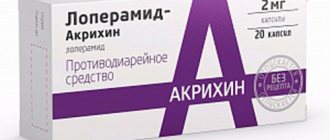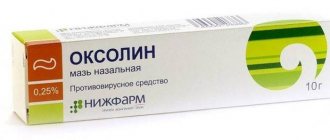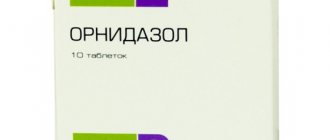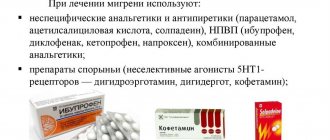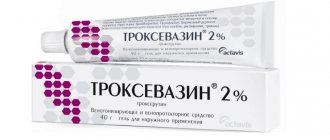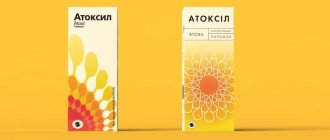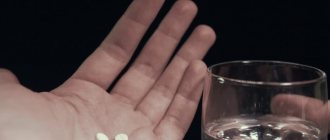Release form and composition
Stopdiar is produced in the following forms:
- film-coated tablets: biconvex, round, yellow (24 pieces in a blister, 1 blister in a cardboard box);
- capsules: size No. 1, gelatin hard, body and cap – yellow; contents of capsules – yellow powder (12 pieces in a blister, 1 blister in a cardboard box);
- suspension for oral administration: pale yellow in color, with a banana odor; During storage, the formation of a sediment is allowed, which disappears after shaking with the suspension returning to a homogeneous state (90 ml in a glass orange bottle with a volume of 125 ml, in a cardboard box 1 bottle with a double dosing spoon with a capacity of 2.5 and 5 ml).
Composition of 1 tablet:
- active ingredient: nifuroxazide – 100 mg;
- additional components: potato starch, hydrophilic aerosil 200, (colloidal silicon dioxide), talc, magnesium stearate, gelatin;
- film shell: polyethylene glycol 20,000, hypromellose, quinoline yellow dye, talc, titanium dioxide.
Composition of 1 capsule:
- active ingredient: nifuroxazide – 200 mg;
- additional components: corn starch, pregelatinized corn starch, magnesium stearate, sucrose;
- cap and capsule body: titanium dioxide, gelatin, yellow iron oxide dye.
Composition of 5 ml suspension:
- active ingredient: nifuroxazide – 220 mg;
- additional substances: sodium hydroxide, carbomer, methyl parahydroxybenzoate, citric acid monohydrate, sucrose, antifoam emulsion (30% simethicone emulsion), water, banana flavor.
Pharmacological properties
Pharmacodynamics
Nifuroxazide is an antimicrobial agent derived from nitrofuran. The substance exhibits high antibacterial activity against Clostridium perfringens, Shigella spp., Salmonella spp., Escherichia coli, Vibrio cholerae, Campylobacter jejuni, pathogenic Staphylococcus spp., Vibrio parahaemolyticus and Vibrions. Weak sensitivity to nifuroxazide is observed in Citrobacter spp., Proteus indologenes and Enterobacter cloacae. Klebsiella spp., Pseudomonas spp., Providencia spp., Proteus mirabilis are resistant to the drug.
The active component of Stopdiar does not disturb the balance of the normal bacterial flora of the intestine. The detailed mechanism of action of the substance is unknown; it is assumed that it suppresses the activity of dehydrogenases and interferes with the synthesis of proteins in pathogenic bacteria. The drug has bacteriostatic properties in moderate therapeutic doses, and bactericidal properties in higher doses. The effectiveness of the drug is noted from the first hours of therapy.
Nifuroxazide does not cause the emergence of resistant strains of pathogens, and the development of cross-resistance to other antibacterial agents is not observed with its use. This makes it possible, if necessary, to use the drug for generalized infections in complex treatment with systemic drugs. Against the background of intestinal infections of a viral nature, nifuroxazide prevents the occurrence of bacterial superinfection.
The effect of the drug is not influenced by either the pH in the intestinal lumen or the sensitivity of microorganisms to antibacterial agents. The drug acts exclusively in the intestinal lumen.
Pharmacokinetics
Since nifuroxazide is sparingly soluble, after oral administration it is virtually not absorbed from the gastrointestinal tract (GIT), forming a high concentration in the intestine. Due to these pharmacokinetic characteristics, the substance demonstrates exclusively an enteral antimicrobial effect, does not exhibit systemic antibacterial activity and does not have a general toxic effect. Stopdiar is excreted through the intestines. Does not affect biochemical and clinical blood test parameters.
Indications for use
Pills
The tablets are recommended for use in acute and chronic diarrhea caused by bacteria sensitive to nifuroxazide.
Capsules
Capsules are indicated for acute bacterial diarrhea that occurs without fever, deterioration of general condition, or intoxication.
Suspension
The suspension is used for acute and chronic diarrhea caused by intestinal gram-positive bacteria (Streptococcus spp., Staphylococcus spp.), as well as some gram-negative bacteria (Enterobacter spp., Proteus spp., Escherichia coli, Klebsiella spp., Shigella spp., Salmonella spp. , Haemophilus influenzae).
Instructions for use of Stopdiar: method and dosage
Stopdiar is taken orally.
Pills
The tablets are swallowed whole, without crushing or chewing, with a sufficient amount of water.
Stopdiar for children over 7 years of age and adults is prescribed 4 times a day every 6 hours, 200 mg (2 tablets). The course of treatment is 3 days. If after this period it is not possible to achieve the desired effect, you must contact a specialist.
Capsules
Children aged 3 to 6 years take 200 mg (1 capsule) 3 times a day, the daily dose should not exceed 600 mg.
Children over 6 years of age and adults take Stopdiar 4 times a day, 200 mg, daily dose – 800 mg. If there is no improvement in the condition during the first 3 days of therapy, you should consult a specialist.
Suspension
Stopdiar suspension should be taken at regular intervals, regardless of meals. Duration of therapy is 5–7 days.
Recommended dosage regimen taking into account the patient's age:
- from 2 to 6 months: 2 times a day, 1–2 measuring spoons per 2.5 ml;
- from 6 months to 6 years: 3 times a day, 1 measuring spoon per 5 ml;
- from 6 years and older: 4 times a day, 1 measuring spoon per 5 ml.
One measuring spoon with a capacity of 2.5 ml contains 110 mg of nifuroxazide, with a capacity of 5 ml - 220 mg.
Before using the drug, the bottle should be shaken thoroughly until a homogeneous suspension is obtained.
Stopdiar (susp. for intravenous administration 220 mg/5 ml 90 ml)
A country
Romania
The country of production may vary depending on the batch of goods. Please check with the operator for detailed information when confirming your order.
Active substance
Nifuroxazide
Compound
Bottle 90 ml
Nifuroxazide 220 mg per 5 ml. Excipients: carbomer - 11 mg, sucrose - 1100 mg, sodium hydroxide - 2.2 mg, citric acid monohydrate - 0.83 mg, simethicone emulsion 30% (antifoam emulsion) - 11 mg, methyl parahydroxybenzoate - 5.5 mg, banana flavor - 4.57 mg, water - up to 5 ml. Suspension for oral administration is light yellow in color, with a banana odor. During storage, sediment may form; after shaking, it returns to the state of a homogeneous suspension.
pharmachologic effect
Nifuroxazide is an antimicrobial agent derived from nitrofuran. Blocks the activity of dehydrogenases and inhibits the respiratory chain, the tricarboxylic acid cycle and a number of other biochemical processes in the microbial cell. Destroys the microbial cell membrane, reduces the production of toxins by microorganisms. Highly active against Campylobacter jejuni, Escherichia coli, Salmonella spp., Shigella spp.; Clostridium perfringens, Vibrio cholerae, pathogenic Vibrions and Vibrio parahaemolytique, Staphylococcus spp. Weakly sensitive to nifuroxazide: Citrobacter spp., Enterobacter cloacae and Proteus indologenes. Resistant to nifuroxazide: Klebsiella spp., Proteus mirabilis, Providencia spp., Pseudomonas spp. Nifuroxazide does not disturb the balance of intestinal microflora. In acute bacterial diarrhea, it restores intestinal eubiosis. When infected with enterotropic viruses, it prevents the development of bacterial superinfection.
Indications for use
Acute bacterial diarrhea, occurring without deterioration in general condition, increase in body temperature, or intoxication.
Mode of application
The drug is used orally. Before taking the drug, shake the bottle several times so that the suspension becomes homogeneous. The drug can be taken with water. Children aged 1 to 6 months: 110 mg (1 small scoop of suspension) 2-3 times a day (interval between doses 8-12 hours). Children aged 6 months to 3 years: 110 mg (1 small scoop of suspension) 3 times a day (interval between doses 8 hours). Children aged 3 to 6 years: 220 mg (1 large scoop of suspension) 3 times a day (interval between doses 8 hours). Children aged 6 to 18 years: 220 mg (1 large scoop of suspension) 3-4 times a day (interval between doses 6-8 hours). Adults: 220 mg (1 large scoop of suspension) 4 times a day (interval between doses 6 hours). The drug Stopdiar should be used for 5-7 days, but not more than 7 days. If there is no improvement within the first 3 days of taking it, you should consult a doctor. The drug should be used only in accordance with the method of application and in the doses indicated in the instructions. If necessary, consult a doctor before using the drug.
Interaction
Concomitant use with drugs that cause the development of disulfiram-like reactions and with drugs that depress the function of the central nervous system is not recommended. If the patient is taking other medications (including over-the-counter medications), you should consult your doctor before using Stopdiar.
Side effect
Allergic reactions: skin rash, urticaria, Quincke's edema, anaphylactic shock.
Contraindications
- hypersensitivity to nifuroxazide, nitrofuran derivatives or any excipients of the drug;
- fructose intolerance, glucose-galactose malabsorption syndrome or sucrase and isomaltase deficiency; - pregnancy; — neonatal period up to 1 month; - prematurity. Use during pregnancy and lactation No teratogenic effect was detected in animal studies. However, as a precaution, taking nifuroxazide during pregnancy is not recommended. During the lactation period, it is possible to continue breastfeeding in case of a short course of treatment with the drug. You should consult your doctor.
Overdose
Overdose symptoms are not known. In case of overdose, symptomatic treatment should be carried out.
special instructions
When treating diarrhea, rehydration therapy must be carried out simultaneously with nifuroxazide therapy. Treatment of diarrhea in children under 3 years of age is recommended under medical supervision. In case of bacterial diarrhea with signs of systemic damage (deterioration of general condition, increased body temperature, symptoms of intoxication or infection), you should consult a doctor to decide on the use of systemic antibacterial drugs. If symptoms of hypersensitivity occur (shortness of breath, rash, itching), you should stop taking the drug. Alcohol consumption is prohibited during therapy. The drug Stopdiar contains sucrose. Patients with rare hereditary disorders of fructose tolerance, glucose-galactose malabsorption, or sucrase and isomaltase deficiency should not take this drug. Due to the content of methyl parahydroxybenzoate, Stopdiar may cause allergic reactions (possibly delayed). 1 small measuring spoon of suspension contains 0.09 XE, 1 large measuring spoon of suspension contains 0.18 XE. The daily dose of the suspension for children aged 1 month to 3 years contains 0.27 XE. The daily dose of the suspension for children aged 3 to 6 years contains 0.54 XE. The maximum daily dose of the suspension for children aged 6 to 18 years contains 0.72 XE. The daily dose of the suspension for adults contains 0.72 XE. Effect on the ability to drive vehicles and machinery The drug does not affect the ability to drive vehicles and machinery.
Side effects
Stopdiar is usually well tolerated; adverse reactions are observed in extremely rare cases. If any of the following symptoms increase or new problems occur, you should consult your doctor.
Pills
If you have hypersensitivity to Stopdiar, in isolated cases the following side effects may occur:
- hematopoietic system: granulocytopenia;
- digestive system: nausea, abdominal pain, worsening diarrhea;
- allergic reactions: skin rash, itching, swelling of the tongue, lips, face, shortness of breath;
- skin and subcutaneous fat: nodular prurigo, skin rash (including pustular).
Capsules
It is possible to develop allergic reactions in the form of urticaria, skin rashes, anaphylactic shock, Quincke's edema.
Suspension
- digestive system: increased diarrhea, nausea, short-term abdominal pain;
- others: isolated cases - itching, skin rashes, shortness of breath.
The appearance of these disorders does not require discontinuation of the Stopdiar suspension.
Contraindications
A contraindication to any dosage form of Stopdiar is individual intolerance to any components in the medication, as well as hypersensitivity to nitrofuran derivatives.
Stopdiar tablets are contraindicated for children under 7 years of age, capsules are not prescribed for children under 3 years of age, and the suspension is not prescribed for prematurity and infants under 2 months.
The following contraindications also exist for Stopdiar in capsules and suspension:
- fructose intolerance;
- glucose-galactose malabsorption syndrome;
- sucrase or isomaltase deficiency;
- pregnancy.
special instructions
During the period of therapy, it is necessary to refrain from drinking ethanol-containing drinks, since ethanol can lead to the development of a disulfiram-like reaction, the symptoms of which are a feeling of heat on the face and upper torso, skin flushing, abdominal pain, vomiting, severe worsening of diarrhea, tachycardia, difficulty breathing, noise in the head, feeling of fear.
In case of bacterial diarrhea, accompanied by signs of systemic damage, such as increased body temperature, deterioration of general condition, symptoms of infection or intoxication, it is necessary to consult a doctor to decide whether to prescribe systemic antibacterial agents.
Stopdiar should not be used for more than 7 days as it is not indicated for long-term therapy.
Due to the fact that the drug is not absorbed from the gastrointestinal tract, in the event of severe invasive diarrhea, the use of systemic antibiotics is necessary.
If symptoms of dehydration appear, it is necessary to replenish fluid loss in the body (parenterally or orally), for adults - approximately 2 liters of fluid per day.
If hypersensitivity reactions occur, stop taking Stopdiar immediately.
While using the product, it is recommended to follow a diet that excludes juices, raw vegetables and fruits, fatty and spicy foods, and spices.
Before prescribing the suspension to infants, it is necessary to ensure that they do not have a congenital deficiency of enzymes that break down sucrose.
Impact on the ability to drive vehicles and complex mechanisms
According to the instructions, Stopdiar does not have a negative effect on the ability to operate complex, potentially dangerous mechanisms, including driving vehicles.
Drug interactions
Due to the fact that the drug is not absorbed from the gastrointestinal tract and cannot enter the circulatory system, its interaction with drugs that have systemic effects is unlikely and is still unknown.
During Stopdiar therapy, it is recommended to avoid its combined use with other oral drugs due to the pronounced adsorption properties of nifuroxazide.
Capsules are not recommended for use in combination with drugs that depress the function of the central nervous system.
Price
The cost of the drug is based on a number of factors, which include:
- Markup for each pharmacy;
- Sales region;
- Transportation costs.
The instructions provide approximate price data. To find out the exact cost, please contact your pharmacy or online store.
Russia
- In Russia, you will have to pay an average of 229 rubles for Stopdiar tablets;
- For a suspension of this drug you will have to pay 351 rubles.
Ukraine
- On average, you will have to pay 112.53 hryvnia for Stopdiar tablets;
- For the suspension in Ukrainian pharmacies, the buyer will be asked to pay 175.23 hryvnia.
Video on the topic: Stopdiar
Reviews of Stopdiar
Almost all reviews about Stopdiar are positive. Patients who have taken the drug speak of it as an effective remedy for the treatment of diarrhea and intestinal infections in children and adults. The suspension is noted to have a pleasant taste and smell, which is important when prescribing Stopdiar for children.
Disadvantages of the drug include the appearance of allergic reactions, and Stopdiar in the form of a suspension has a short shelf life after opening. Some reviews express dissatisfaction with the large amount of flavoring in the suspension.
Storage conditions
The medicine should be kept away from small children and pets.
The drug Stodiar should be stored in a dry place and protected from water. In this room the air temperature should be from 10 to 20 degrees.
If all recommendations are followed, the drug tablets can be used for three years. The suspension can be stored for no more than four years. After the expiration date, further use of the product is not allowed. The drug should be disposed of by placing it in the trash.

